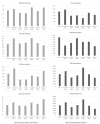Stress-Induced Production of Bioactive Oxylipins in Marine Microalgae
- PMID: 39330287
- PMCID: PMC11432788
- DOI: 10.3390/md22090406
Stress-Induced Production of Bioactive Oxylipins in Marine Microalgae
Abstract
Microalgae, stemming from a complex evolutionary lineage, possess a metabolic composition influenced by their evolutionary journey. They have the capacity to generate diverse polyunsaturated fatty acids (PUFAs), akin to those found in terrestrial plants and oily fish. Also, because of their numerous double bonds, these metabolic compounds are prone to oxidation processes, leading to the creation of valuable bioactive molecules called oxylipins. Moreover, owing to their adaptability across various environments, microalgae offer an intriguing avenue for biosynthesizing these compounds. Thus, modifying the culture conditions could potentially impact the profiles of oxylipins. Indeed, the accumulation of oxylipins in microalgae is subject to the influence of growth conditions, nutrient availability, and stressors, and adjusting these factors can enhance their production in microalgae culture. Consequently, the present study scrutinized the LC-MS/MS profiles of oxylipins from three marine microalgae species (two Haptagophytes and one Chlorophyte) cultivated in 1 L of photobioreactors under varying stress-inducing conditions, such as the introduction of H2O2, EtOAc, and NaCl, during their exponential growth phase. Approximately 50 oxylipins were identified, exhibiting different concentrations depending on the species and growth circumstances. This research suggests that microalgae metabolisms can be steered toward the production of bioactive oxylipins through modifications in the culture conditions. In this instance, the application of a low dose of hydrogen peroxide to Mi 124 appears to stimulate the production of nonenzymatic oxylipins. For Mi136, it is the application of salt stress that seems to increase the overall production of oxylipins. In the case of Mi 168, either a low concentration of H2O2 or a high concentration of AcOEt appears to have this effect.
Keywords: LC-MS/MS; microalgae; osmotic stress; oxidative stress; oxylipins.
Conflict of interest statement
Authors Amandyne Linares-Maurizi and Rémi Pradelles were employed by the company Microphyt and the other authors declare that there are no potential conflicts of interest. The role of Microphyt in the study design, collection, analysis, interpretation of data, the writing of this article or the decision to submit it for publication should be further clarified.
Figures





Similar articles
-
Bioactive Oxylipins Profile in Marine Microalgae.Mar Drugs. 2023 Feb 22;21(3):136. doi: 10.3390/md21030136. Mar Drugs. 2023. PMID: 36976185 Free PMC article.
-
Isoprostanoid Profiling of Marine Microalgae.Biomolecules. 2020 Jul 18;10(7):1073. doi: 10.3390/biom10071073. Biomolecules. 2020. PMID: 32708411 Free PMC article.
-
LC-MS/MS-MRM-Based Targeted Metabolomics for Quantitative Analysis of Polyunsaturated Fatty Acids and Oxylipins.Methods Mol Biol. 2019;1978:107-120. doi: 10.1007/978-1-4939-9236-2_7. Methods Mol Biol. 2019. PMID: 31119659
-
Human health benefits of very-long-chain polyunsaturated fatty acids from microalgae.Biochimie. 2020 Nov;178:15-25. doi: 10.1016/j.biochi.2020.04.022. Epub 2020 May 7. Biochimie. 2020. PMID: 32389760 Review.
-
Marine microalgae for production of biofuels and chemicals.Curr Opin Biotechnol. 2018 Apr;50:111-120. doi: 10.1016/j.copbio.2017.11.018. Epub 2017 Dec 10. Curr Opin Biotechnol. 2018. PMID: 29232601 Review.
Cited by
-
Marine Phytoplankton Bioactive Lipids and Their Perspectives in Clinical Inflammation.Mar Drugs. 2025 Feb 17;23(2):86. doi: 10.3390/md23020086. Mar Drugs. 2025. PMID: 39997210 Free PMC article. Review.
References
-
- Abdur Razzak S., Bahar K., Islam K.M.O., Haniffa A.K., Faruque M.O., Hossain S.M.Z., Hossain M.M. Microalgae Cultivation in Photobioreactors: Sustainable Solutions for a Greener Future. Green. Chem. Eng. 2023 doi: 10.1016/j.gce.2023.10.004. - DOI
MeSH terms
Substances
LinkOut - more resources
Full Text Sources

